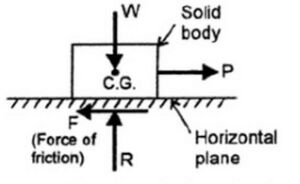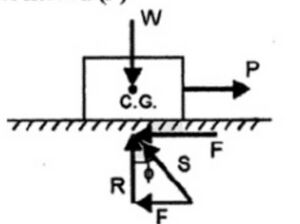Friction
When a solid body slides over a stationary solid body, a force is exerted at the surface of contact by the stationary body on the moving body. This force is called as the force of friction and is always acting in the direction opposite to the direction of motion.
Friction is defined as the contact resistance exerted by one body upon a second body when the second body moves or tends to move past the first body.
Friction is a property of the bodies by virtue of which a force is exerted by a stationary body on the moving body to resist the motion of the moving body.[1] Friction acts parallel to the surface of contact and depends on the nature of surface of contact.
The different contact surfaces are i) dry ii) partially lubricated (greasy) iii) completely lubricated (film lubricated).
Force of friction should be reduced or increased. Reducing the force of friction is needed when the power transmitted is partially lost due to friction, the friction must be reduced by using lubricated surfaces.
Terminology
Limiting force of friction
Consider a solid body placed on a horizontal plane surface.
W = Weight of body acting through centre of gravity downward,
R = Normal reaction of body acting through centre of gravity upward,
P = Force acting on the body through centre of gravity parallel to the horizontal surface
if the force P is small , the body will not move as the force of friction F acting on the body in the opposite direction of force P will be more than P. But if the force P is increased at some point when the solid body is on the point of motion. At that point force of friction F acting on the body is called limiting force of friction. Limiting force of friction is denoted by F.
By resolving the horizontal and vertical forces acting on the body, we get R = W and F = P
Kinetic Friction
if the force P is increased further, the body will start moving. The force of friction acting on the body, when the body is moving is called Kinetic Friction.
Coefficient of Friction (μ)
Hence F = μR ........................ (1)
Approximate Values of Coefficient of Static Friction for dry surfaces.
| Metal on metal | 0.15 - 0.60 |
| Metal on wood | 0.20 - 0.60 |
| Metal on stone | 0.30 - 0.70 |
| Metal on leather | 0.30 - 0.60 |
| Wood on wood | 0.25 - 0.50 |
| Wood on leather | 0.25 - 0.50 |
| Stone on stone | 0.40 - 0.70 |
| Earth on earth | 0.20 - 1.00 |
| Rubber on concrete | 0.60 - 0.90 |
Angle of Friction (Φ)
Angle of friction is the angle made by the resultant of the normal reaction (R) and the limiting force of Friction (F) with the normal reaction (R) which is denoted by Φ. Fig 2. shows a solid body resting on a rough horizontal plane.
Let S is the resultant of normal reaction (R) and limiting force of Friction (F)
Angle of friction (Φ) = angle between S & R
since F = μR from (1)
...........(2)
So the tangent of the angle of friction is equal to the coefficient of friction.
Types of Friction
Based on the nature of two surfaces in contact friction is classified as
- Static Friction - Two surfaces are in contact and at rest , the force experienced by one surface is called Static Friction.[2]
- Dynamic Friction - One surface starts moving while the other is at rest , the force experience by the moving surface is called Dynamic Friction.
Based on the conditions of surfaces friction is classified as
- Dry Friction - The friction that exists between the two surfaces when no lubricant is used is called Dry Friction. It is further classified as
- Solid Friction - When the two surfaces have sliding motion relative to each other , then the friction between the two surfaces is known as Solid Friction. Ex: friction occurring when we push a wooden box on the floor
- Rolling Friction - When one surface is rolling over another surface, then the friction between the two surfaces is known as Rolling Friction. Ex : friction between ball and roller bearing
- Greasy Friction - When the two surfaces in contact have a very thin layer of lubricant between them, the friction between those surfaces is known as Greasy Friction. [3]The lubricant is absorbed on the surfaces and forms a very thin film between these surfaces.
- Viscous Friction - When the two surfaces in contact have a thick layer of lubricant between them, the friction between those surfaces is known as Viscous Friction. Here the surfaces do not come in contact and hence do not rub against each other. Surfaces will have rubbing action with the thick layer of lubricant only.
Laws of Dry Friction
- The force of friction acts in the opposite direction in which surface is having tendency to move.[4]
- The force of friction depends on the roughness of the surfaces in contact
- The force of friction is independent of the area of contact between two surfaces.
- The force of friction is equal to the force which tends the body to move as long as the body is at rest.
- The limiting friction (F) bears a constant ratio to the normal reaction (R) between the two surfaces i.e
External Links
See Also
References
- ↑ Dr. R. K., Bansal,. Theory of Machines. p. 210.
{{cite book}}: CS1 maint: extra punctuation (link) CS1 maint: multiple names: authors list (link) - ↑ Mohan Das, Madan (2010). Basic Engineering Mechanics and Strength of Materials. New Delhi: PHI Learning Private Limited. p. 109.
- ↑ Kumar, Vivek (2008). Dynamics of Machines. New Delhi: Galgotia Publications Pvt. Ltd. p. 136.
- ↑ D P, Sharma. Applied Mechanics. pp. 2–21. ISBN 978-81-317-6486-2.

